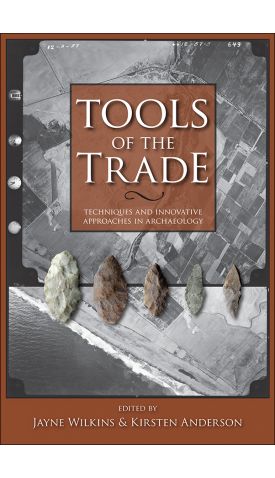אנו משתמשים ב-Cookies כדי לשפר את החוויה שלך. כדי לקיים ההנחיה החדשה של e-Privacy, עלינו לבקש את הסכמתך להגדיר את ה-Cookies. קבלת מידע נוסף.
TOOLS OF THE TRADE : METHODS, TECHNIQUES AND INNOVATIVE APPROACHES IN ARCHAEOLOGY
What does it mean to be us and how can we find out? Tools of the Trade is an impressive collection of essays from archaeologists, covering a diversity of geographic regions and periods.
Tools of the Trade presents a collection of academic papers from international archaeologists, senior professors, and students alike. Each chapter focuses on the discussion and application of unique and innovative ‘tools’ for archaeological analysis and interpretation, including micro- and macro-botanical analysis, experimental study, off-site survey, lithic use-wear, ceramic petrography, DNA analysis, chaëne opératoire, space syntax, and Geographic Information Systems.
As a collective volume, Tools of the Trade also covers an impressive diversity of geographic regions and time periods, such as Precolumbian Mesoamerica, Plio-Pleistocene Africa, prehistoric and historic North America, and ancient Polynesia. Finally, this volume provides a somewhat introspective look at the origins of tool use, technological development, and the means by which we have become the only species to ask the questions: What does it mean to be us and how can we find out?
| מהדורה | 1 |
|---|---|
| עמודים / Pages | 344 pages, 77 illustrations |
| פורמט | Paperback |
| תאריך יציאה לאור | 6 בינו׳ 2009 |
| תוכן עניינים | Introduction Great Ape Tool Use and the Oldowan Natural History Intelligence and Hominid Tool Behaviour Tempo and Mode in the Paleolithic: How to Understand the Origins of Culture A Game of Inches: An Experimental Approach to Understanding How Atlatl Length Affects Performance Microscopic and Use-Wear Studies Plus Microblade Replication: Experiments with Raw and Heat-Treated Glass Buttes Obsidian Making and Understanding Embarras Bipoints: The Replication and Operational Sequencing of a Newly Defined Diagnostic Stone Tool from the Eastern Slopes of Alberta Systematic Properties of Stone Tool Reduction: Curation Analysis of Paleoindian Bifaces and Unifaces The Chaine Operatoire of Ceramic Manufacture and Ceramic Petrography: A Case Study from Rancho del Rio, Northwestern Honduras Archaeometric and Non-Archaeometric Techniques and Their Relevance to Understanding Human Behaviour Stable Isotope Analysis of Marine Shell to Determine Geographic Provenance: Implications for Prehistoric Trade Route Research Molecular Analysis of Ancient Cervid Remains rom Two Archaeological Sites: Banff National Park and Rocky Mountain House National Historic Site, Alberta Tools for Interpreting Past Plant Use by Subarctic and Northern Northwest Coast Peoples Variable Wetland Use at the Mono Lake: Basin, Eastern California: Perspectives from a Non-Site Approach Fill in the Gap between Theory and Practice: Making a GIS-based Digital Map of Pachacamac Economy in Ancient Egypt: The Use of GIS for Understanding Different Spheres of Exhchange A Space Syntax Analysis of Dohack and Range Phase Villages in the American Bottom The Spatial Morphology of Deficient Samples: Applying ‘Special String-Matching’ Methods to an Incomplete Data of Vernacular Houses Contributors |
| Author | Edited by Jayne Wilkins and Kirsten Anderson |



Login and Registration Form